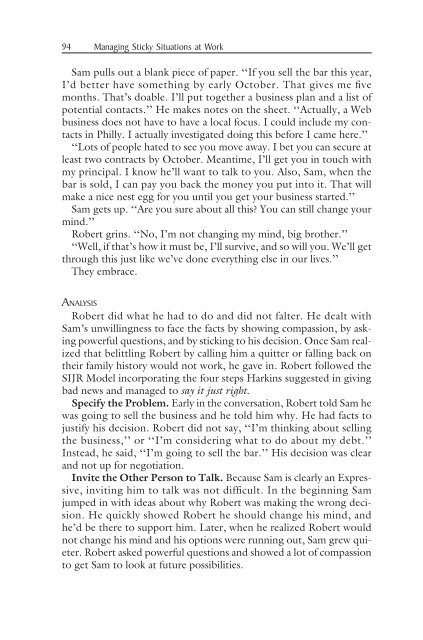Managing Sticky Situations at Work
Managing Sticky Situations at Work
Managing Sticky Situations at Work
Create successful ePaper yourself
Turn your PDF publications into a flip-book with our unique Google optimized e-Paper software.
94 <strong>Managing</strong> <strong>Sticky</strong> <strong>Situ<strong>at</strong>ions</strong> <strong>at</strong> <strong>Work</strong>Sam pulls out a blank piece of paper. ‘‘If you sell the bar this year,I’d better have something by early October. Th<strong>at</strong> gives me fivemonths. Th<strong>at</strong>’s doable. I’ll put together a business plan and a list ofpotential contacts.’’ He makes notes on the sheet. ‘‘Actually, a Webbusiness does not have to have a local focus. I could include my contactsin Philly. I actually investig<strong>at</strong>ed doing this before I came here.’’‘‘Lots of people h<strong>at</strong>ed to see you move away. I bet you can secure <strong>at</strong>least two contracts by October. Meantime, I’ll get you in touch withmy principal. I know he’ll want to talk to you. Also, Sam, when thebar is sold, I can pay you back the money you put into it. Th<strong>at</strong> willmake a nice nest egg for you until you get your business started.’’Sam gets up. ‘‘Are you sure about all this? You can still change yourmind.’’Robert grins. ‘‘No, I’m not changing my mind, big brother.’’‘‘Well, if th<strong>at</strong>’s how it must be, I’ll survive, and so will you. We’ll getthrough this just like we’ve done everything else in our lives.’’They embrace.ANALYSISRobert did wh<strong>at</strong> he had to do and did not falter. He dealt withSam’s unwillingness to face the facts by showing compassion, by askingpowerful questions, and by sticking to his decision. Once Sam realizedth<strong>at</strong> belittling Robert by calling him a quitter or falling back ontheir family history would not work, he gave in. Robert followed theSIJR Model incorpor<strong>at</strong>ing the four steps Harkins suggested in givingbad news and managed to say it just right.Specify the Problem. Early in the convers<strong>at</strong>ion, Robert told Sam hewas going to sell the business and he told him why. He had facts tojustify his decision. Robert did not say, ‘‘I’m thinking about sellingthe business,’’ or ‘‘I’m considering wh<strong>at</strong> to do about my debt.’’Instead, he said, ‘‘I’m going to sell the bar.’’ His decision was clearand not up for negoti<strong>at</strong>ion.Invite the Other Person to Talk. Because Sam is clearly an Expressive,inviting him to talk was not difficult. In the beginning Samjumped in with ideas about why Robert was making the wrong decision.He quickly showed Robert he should change his mind, andhe’d be there to support him. L<strong>at</strong>er, when he realized Robert wouldnot change his mind and his options were running out, Sam grew quieter.Robert asked powerful questions and showed a lot of compassionto get Sam to look <strong>at</strong> future possibilities.















